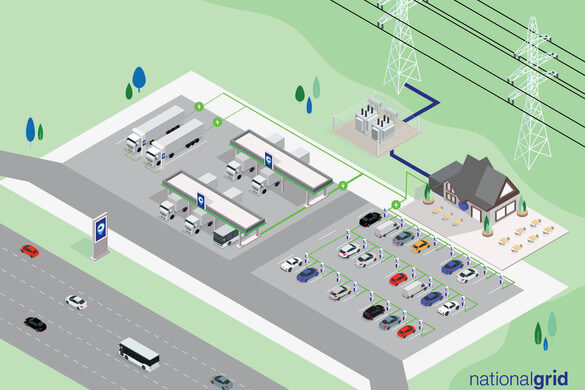National Grid, along with transportation analytics organizations CALSTART, RMI, Geotab and Stable Auto, have conducted an analysis to provide new insight into the future of electric vehicle highway charging in New York and Massachusetts and to better understand the impact of this transition on the grid.
EV charging needs along Massachusetts and New York highways will require interconnection to high-capacity transmission lines in the next decade, finds the study. The Electric Highways Study provides a blueprint for the strategic buildout of fast-charging sites along highway corridors to meet an upcoming surge in demand from the electrification of passenger vehicles and commercial trucks.
EV adoption is expected to accelerate nationwide due to market forces and federal policy changes, including the Infrastructure Investment and Jobs Act of 2021 and the Inflation Reduction Act of 2022. At the state level, New York’s adoption of the Advanced Clean Cars II regulation and Massachusetts’ passage of “An Act Driving Clean Energy and Offshore Wind” will ban the sale of gas-only passenger vehicles by 2035.
The Electric Highways Study can help utilities and policymakers make smarter decisions about electric grid interconnections and infrastructure, avoiding repeated upgrades and ensuring grid readiness does not hinder the clean energy transition.
“This kind of holistic, long-term infrastructure planning will be critical to delivering a clean energy transition as efficiently as possible,” says Brian Gemmell, COO of NY Electric at National Grid. “We have a responsibility to make smart investments that get it right the first time and to make sure the electricity is there when drivers need it. This study will help us do that.”
The study examined current traffic patterns and expected charger use to forecast charging demand at 71 highway sites across New York and Massachusetts. The analysis included relevant EV sales goals and mandates in National Grid’s home states – considering scenarios where all light-duty vehicle sales are electric by 2035 and all medium-and heavy-duty vehicle (MHDV) sales are electric by 2045.
According to the findings, in 10 years more than a quarter of sites studied will require the same amount of power as an outdoor sports stadium to meet charging demand, with some requiring the same power as a small town within the next two decades.
Existing transmission lines, which often mirror highway routes, provide a ready-made solution if highway charging sites can “plug-in” to the high-voltage transmission grid. Strategically future-proofing high-traffic sites will allow states to accelerate cost-effective charging deployment.





The amount of money saved on fossil fuels will take care of any electrical infrastructure. By ten times over.